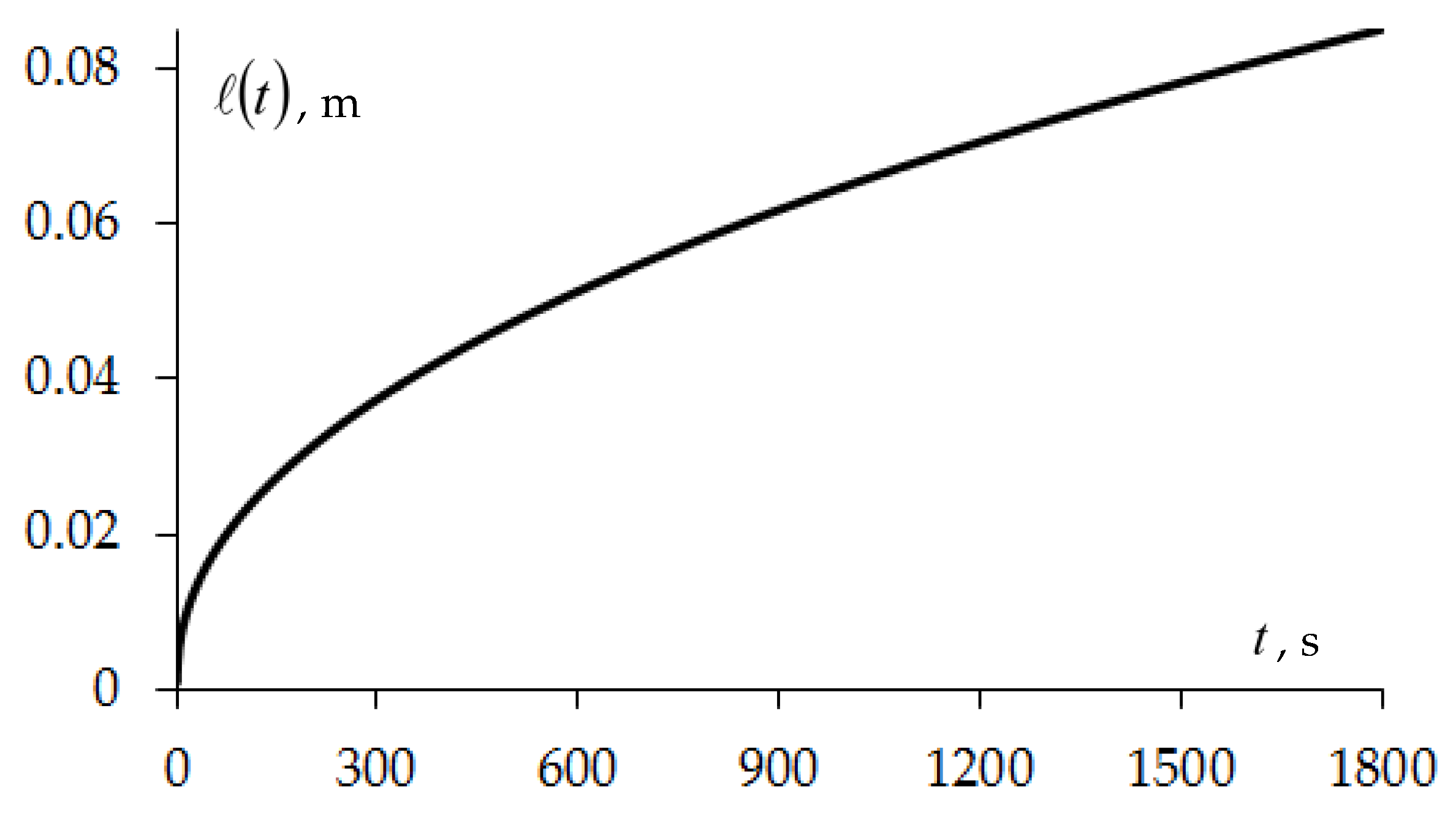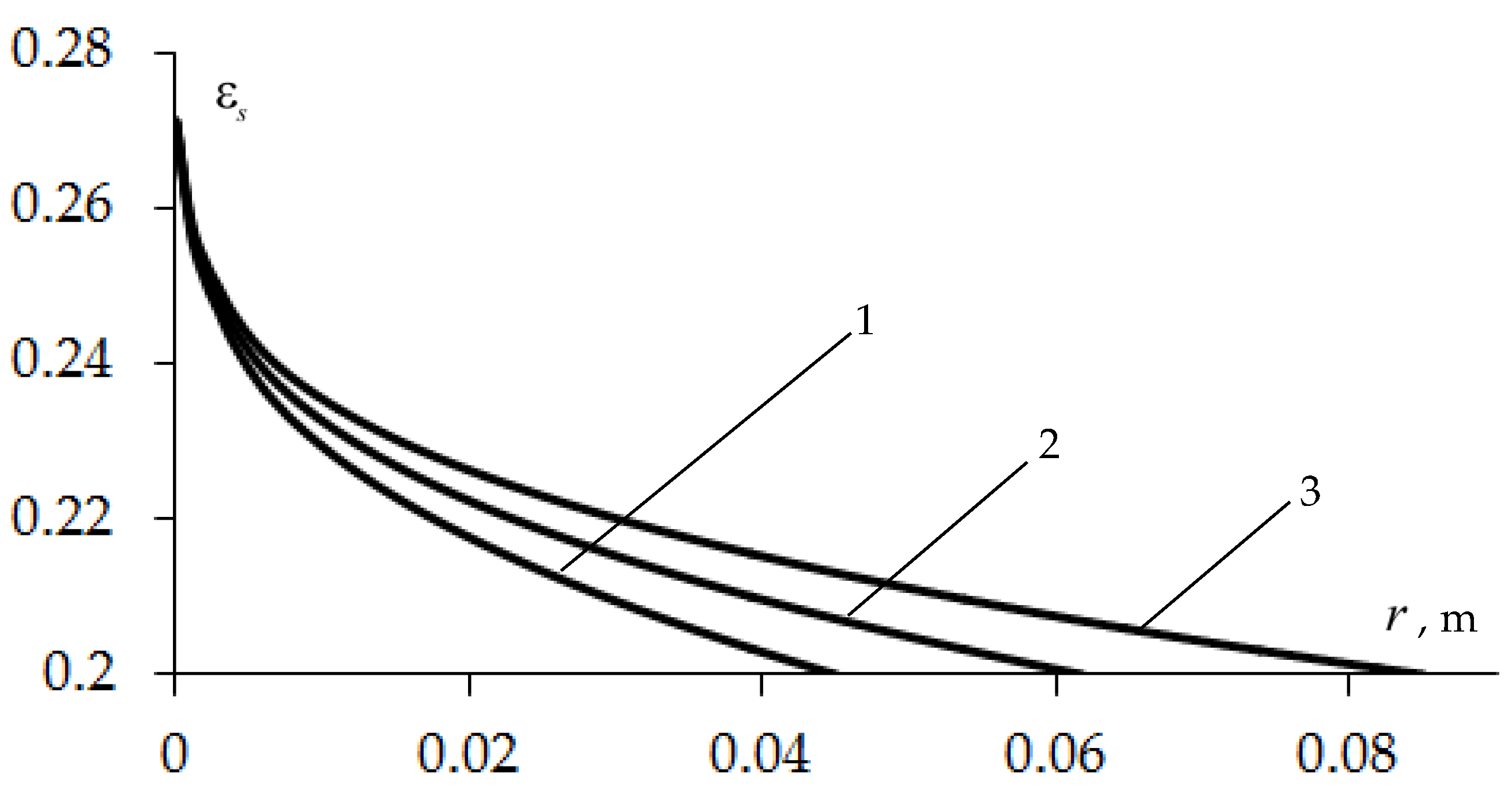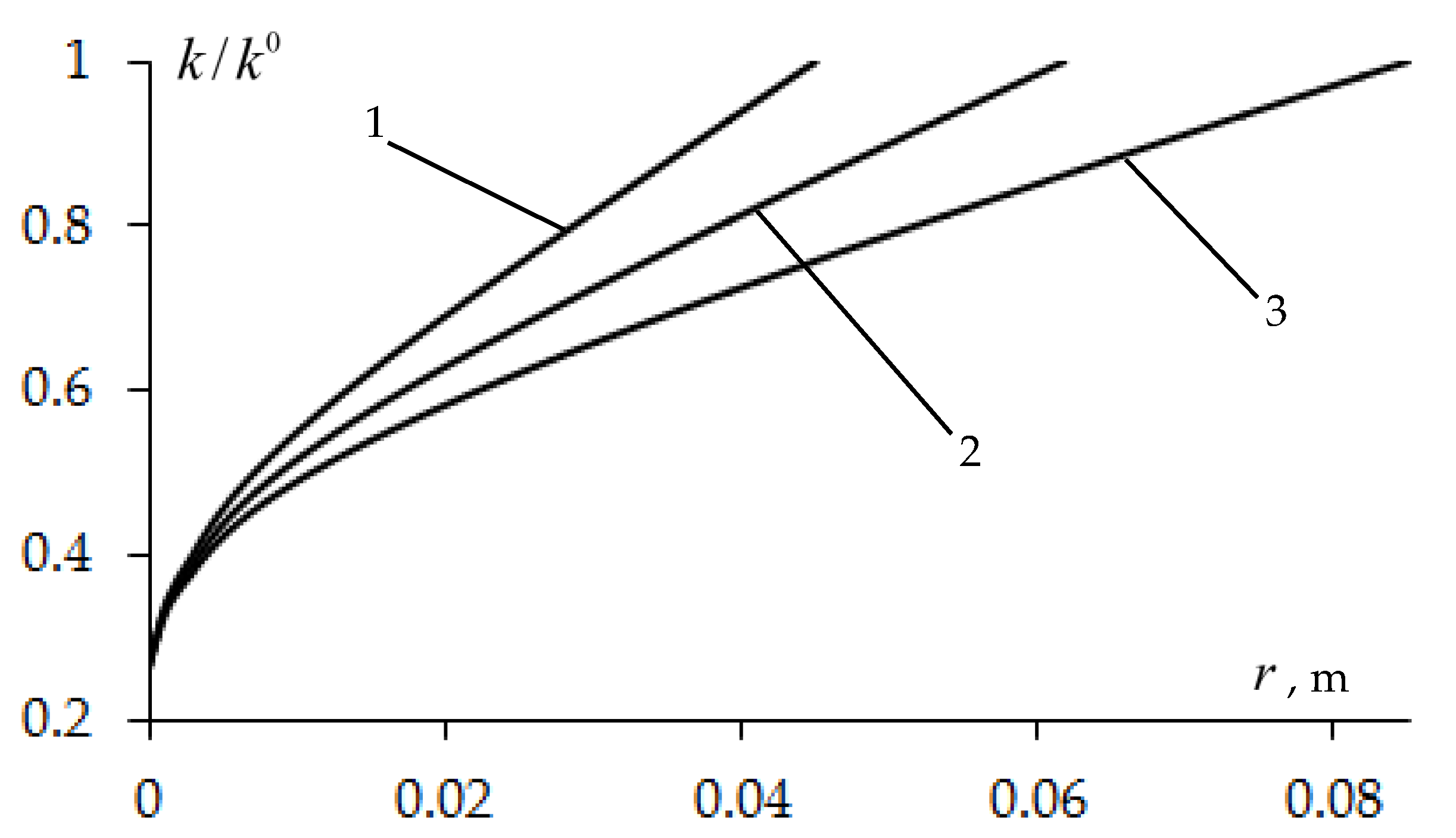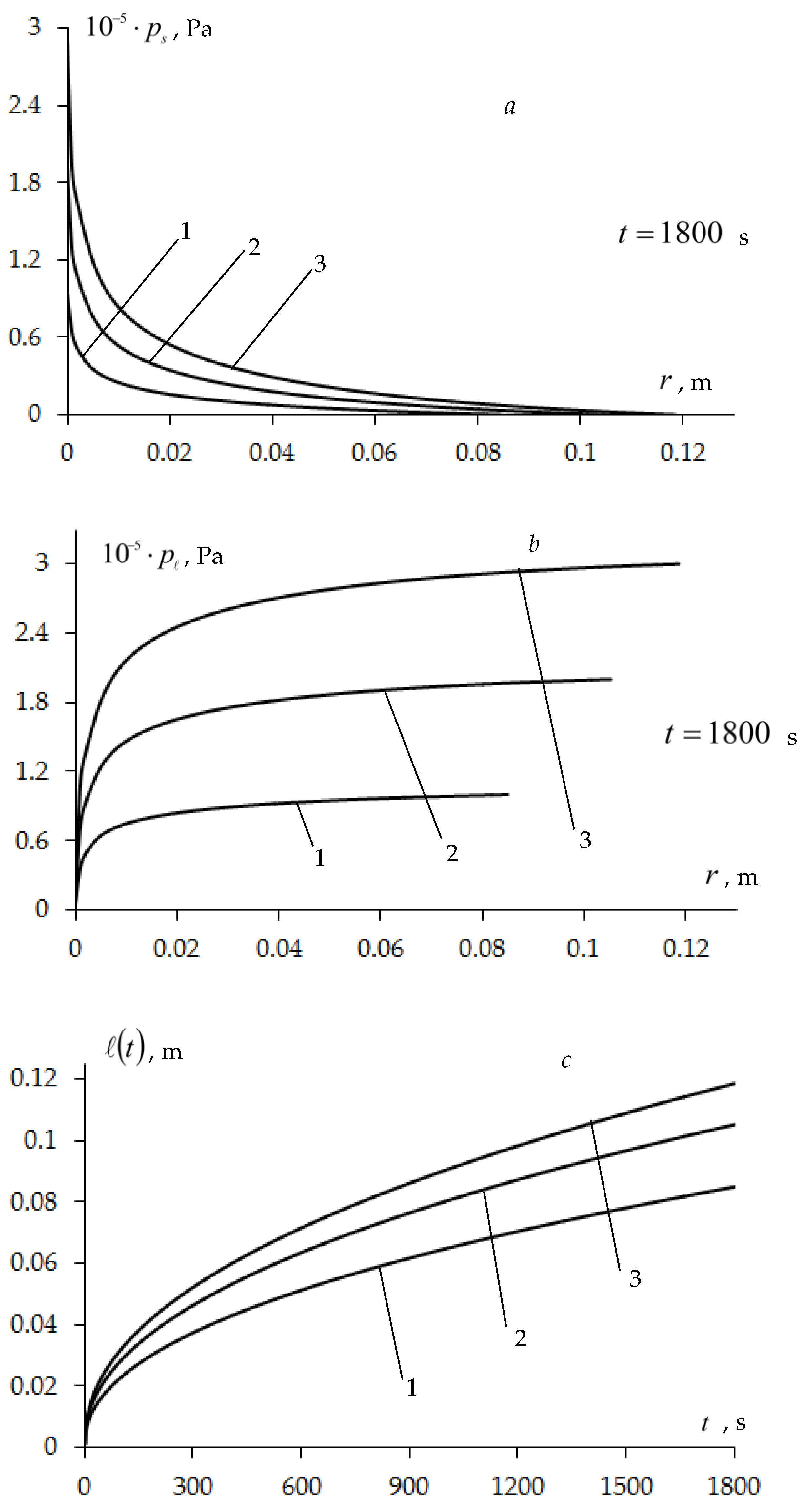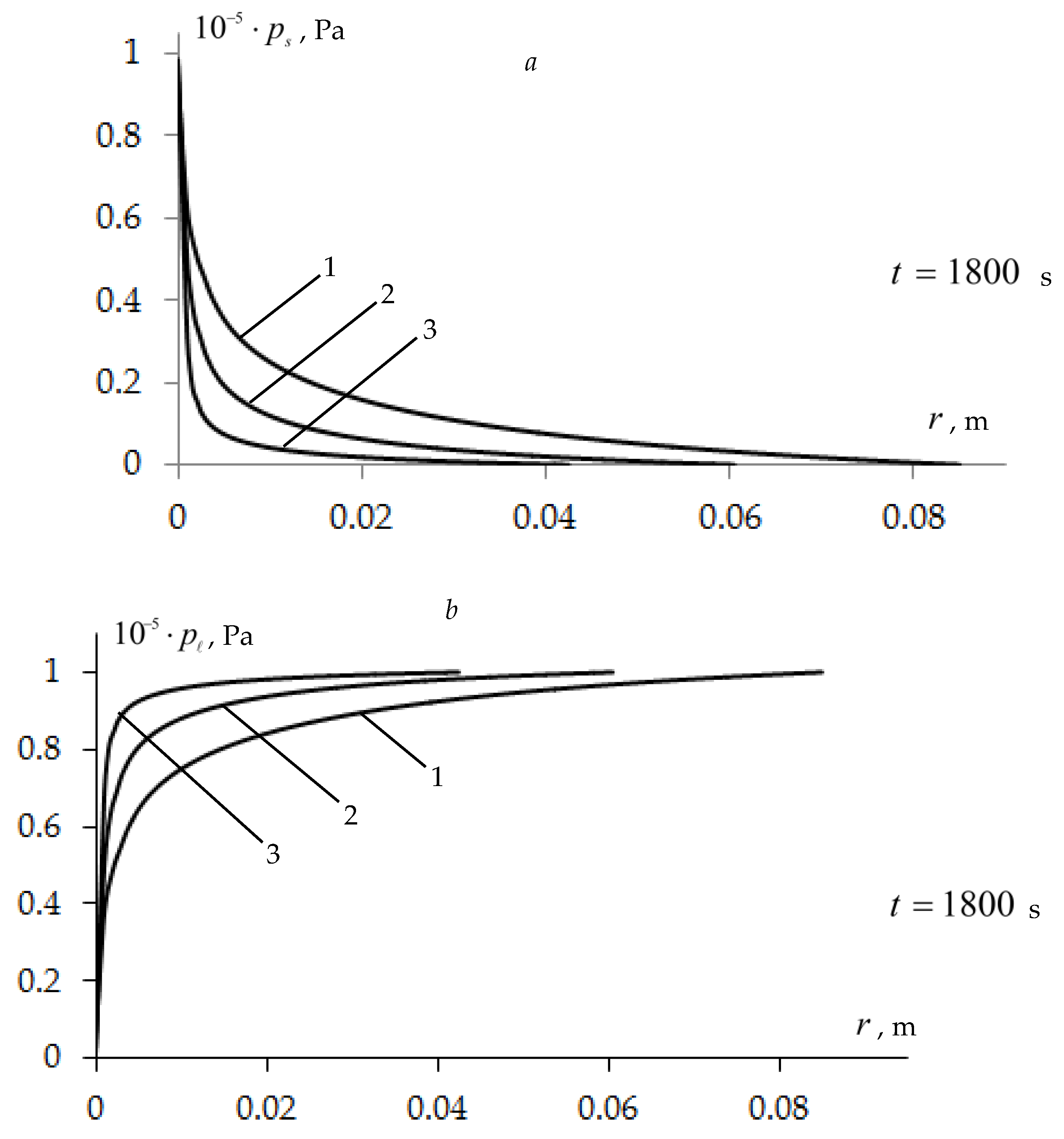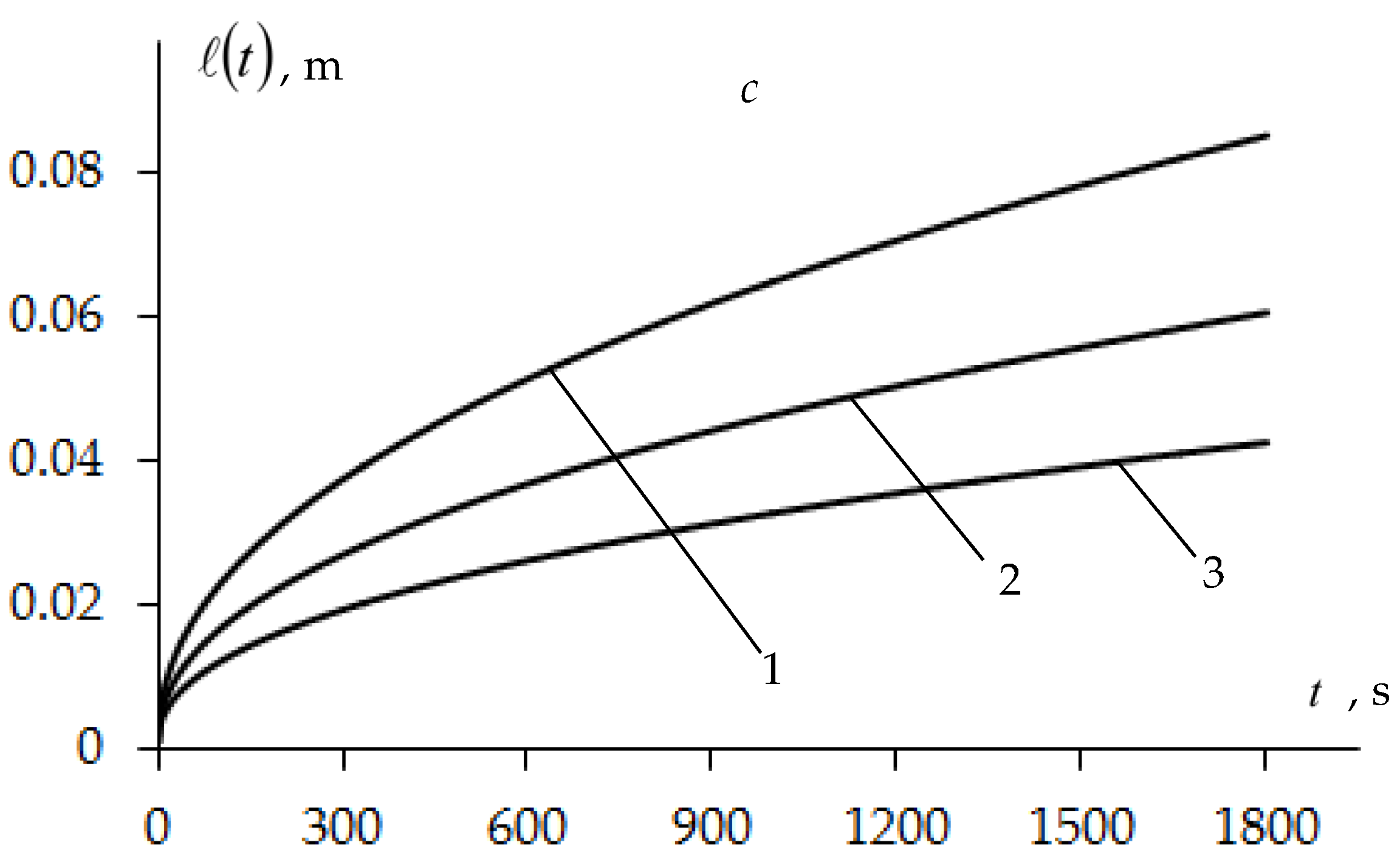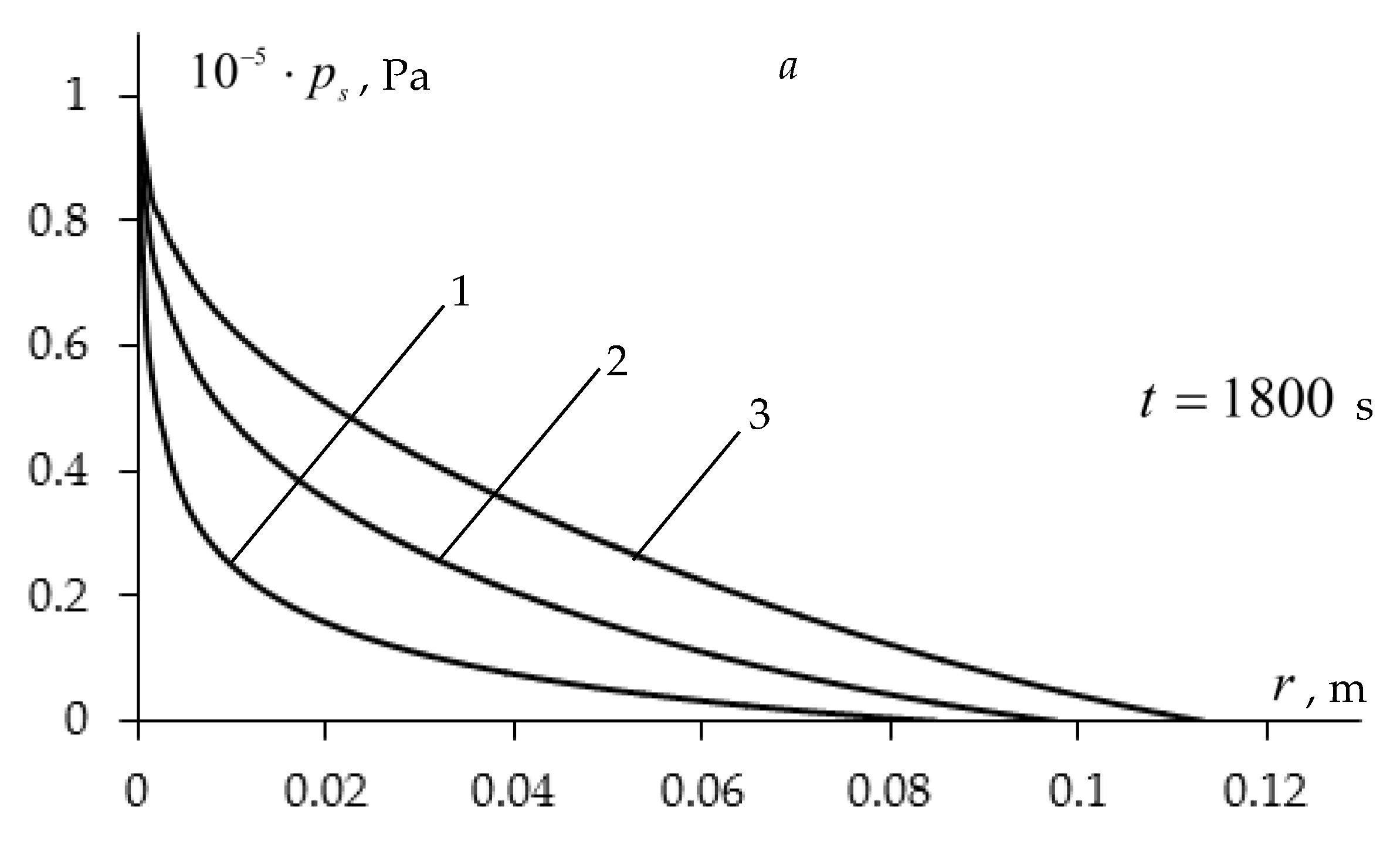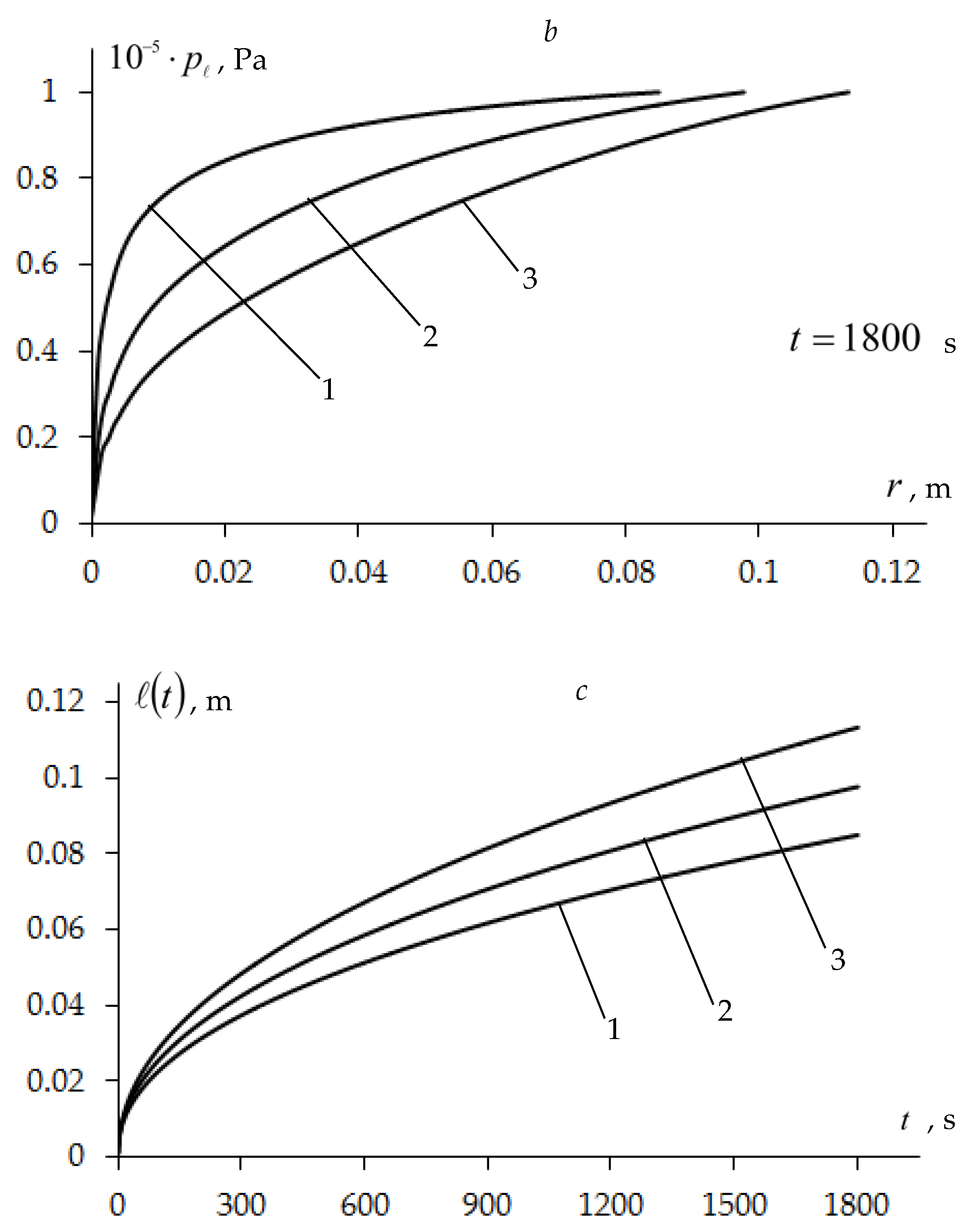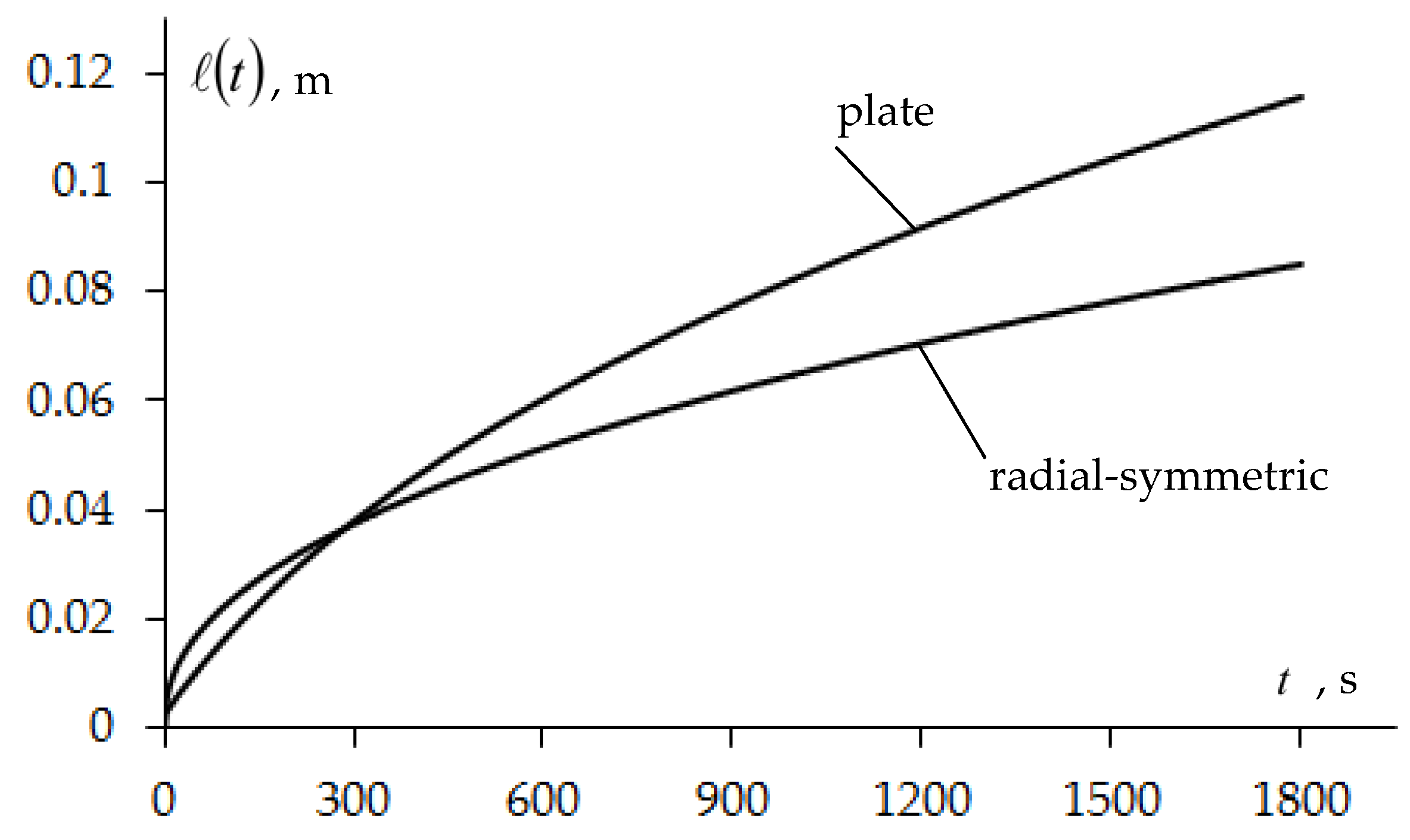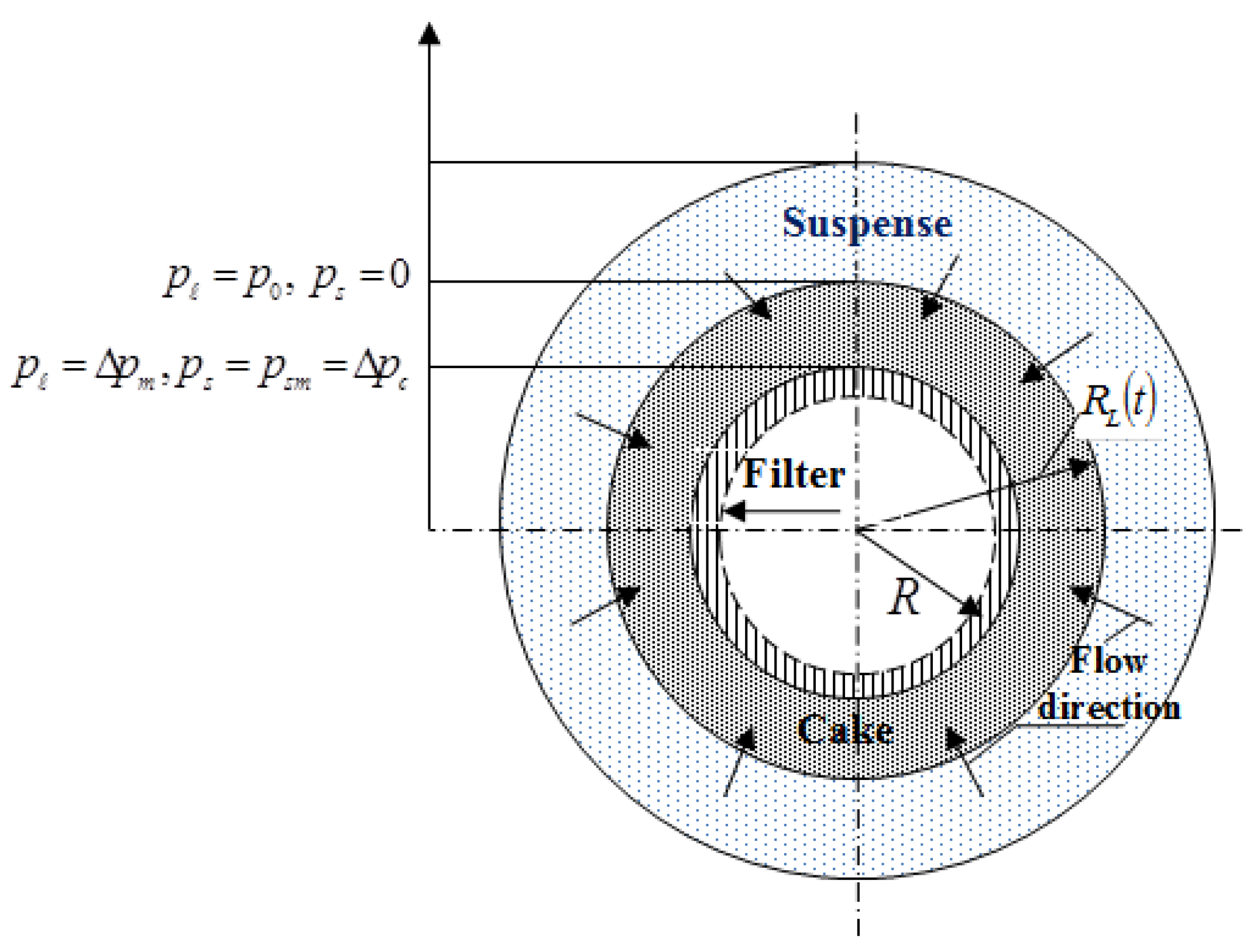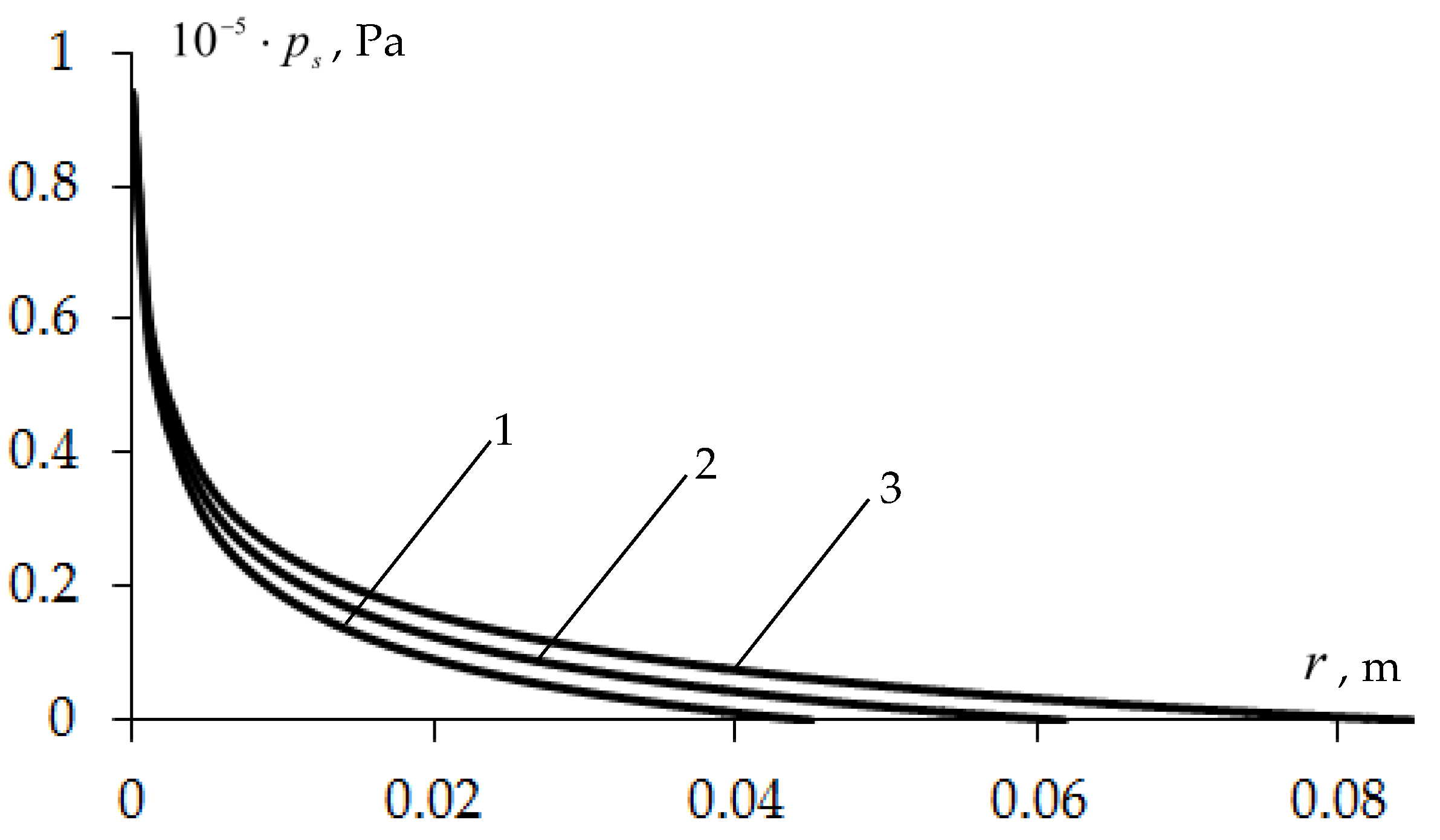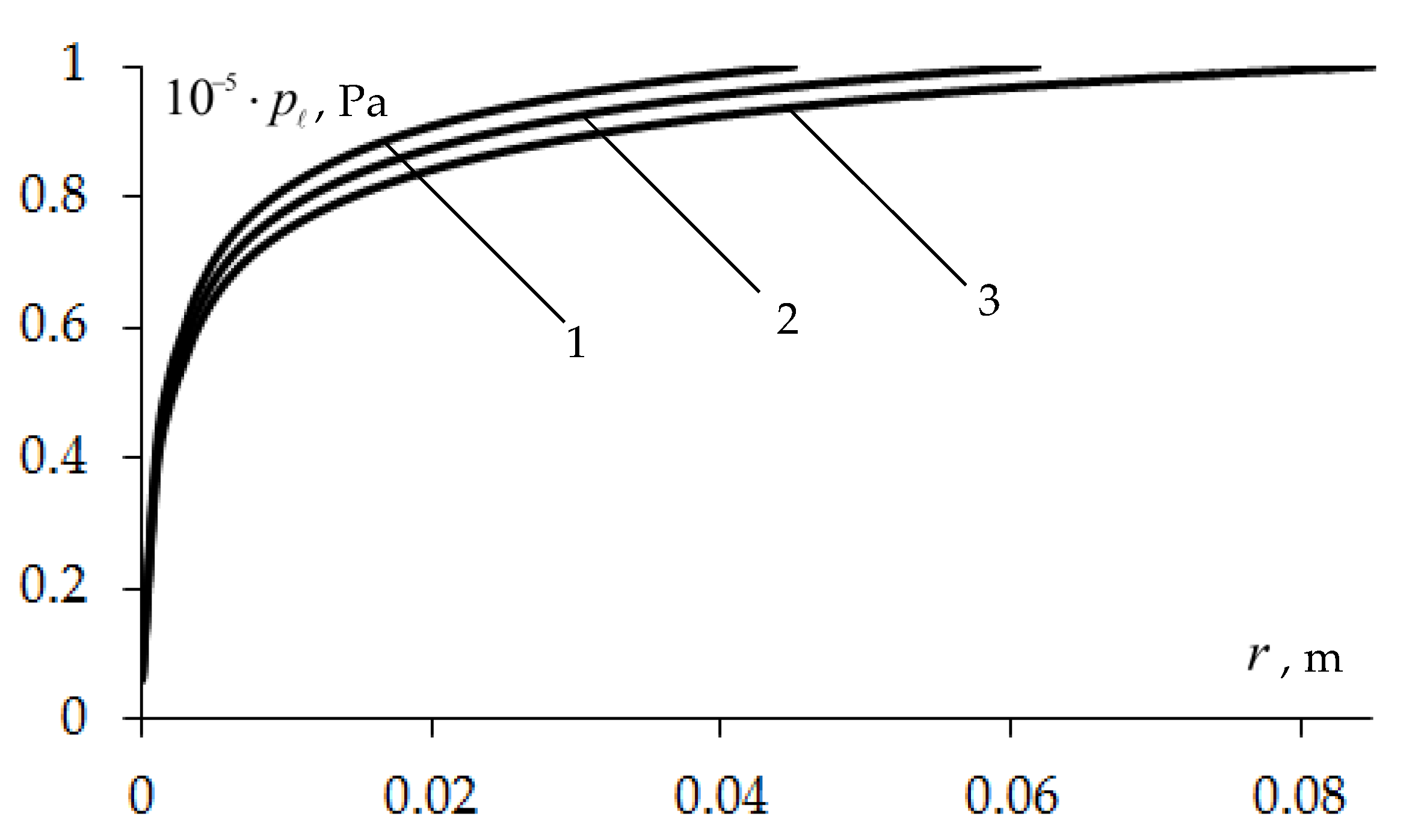1. Introduction
Filtration is the process of separating heterogeneous systems using a porous septum, which delays some phases of these systems and passes others. These processes include the separation of the suspension into a clean liquid and sediment. The separation of the suspension in which solid particles are suspended is carried out using a filter. Suspension separation processes are found in chemical, petrochemical, oil refining, coal, food, and other industries [
1,
2,
3,
4,
5,
6,
7,
8,
9,
10,
11].
The most important characteristic of suspensions affecting the type and intensity of filtration is the concentration of the solid phase, which is expressed in fractions of volume or mass. Depending on the concentration of the solid phase in the suspension, the types of filtration are distinguished [
1,
2,
3]: with the formation of a precipitate, it is intermediate, and with the clogging of the pores of the precipitate, it is gradual, as well as with a complete clogging of the pores of the filter partition. Solids contained in the suspension are retained on the surface of the septum and form a layer of sediment.
Filtering with the formation of a cake is based on the fundamental equations of the mechanics of multicomponent media and the theory of filtration consolidation, taking into account the influence of hydrodynamic and rheological factors on the laws of the filtering process [
5,
6].
In the theory of filtering, the main averaged characteristics are the filtering velocity and the pressure. The process of suspension flow in a porous medium is described by Darcy’s law. In [
12,
13,
14,
15], the averaged equations for the mechanics of two-phase flows were given, and filtering equations were obtained. In [
1,
4], dynamic equations were obtained via a statistical averaging of the equations for the mechanics of two-phase flows, taking into account the inertial effects during filtering. The differential filtering equations in [
7,
12,
13,
14,
15,
16,
17] were obtained on the basis of the equations for the mechanics of two-phase flows and soil mechanics, taking into account the change in the filtration parameters over the thickness of the sediment and over time.
Since in the process of filtering, the sediment–suspension interface is mobile, the models are usually reduced to Stefan problems [
1,
4,
7], the numerical solution of which, as is known, has a number of specific features [
18,
19,
20,
21,
22,
23,
24].
When filtering the clarification of a suspension, one of the main technical elements are the filters, the design and technical characteristics of which can be different [
1,
4]. In this case, particles of the suspension either linger on the surface of the filter, forming a precipitate called a cake, or penetrate the filter, lingering in the pores. In accordance with this, filtering is distinguished by the formation of a cake and filtering with clogged pores [
1,
2,
4]. The filter element often has a cylindrical shape, through which a suspension is supplied through the inner- or outer-side surface.
In this paper, the axisymmetric problem of suspension filtration is considered, taking into account the consolidation of the cake. We use here a geometric schematization of the filter, as seen in [
5]. To compose a mathematical model, we use the methodology developed in [
1,
2,
3]. Thus, for the first time, filtration equations are derived in a radially symmetric case, taking into account the consolidation of the cake. A suspension filtering problem through a radial filter with a given pressure at the interface between the suspension and the cake is set. The problem is solved numerically using the finite difference method. Since the Stefan problem is obtained for the growth of the cake thickness, a special method of “catching the front” is applied to determine it. The pressure fields in the liquid and solid phases of the cake, the relative permeability of the cake, the concentration of the solid particles in the cake, and the thickness of the cake, as well as other filtering characteristics, are determined. The influence of the parameters on the dependencies of the cake solid concentration and the permeability of the pressure in the solid phases on the filtration characteristics are studied.
3. Mathematical Model
Here, we give the derivation of the filtering equation. We suppose that the filtering occurs in the radial direction, which means that the direction of the velocities of the liquid and suspended particles coincide with this radial direction. Therefore, we ignore the angular flow of the suspension in our adopted scheme (geometry) for the filtering and consider it as one-dimensional. Multi-dimensional equations arise in non-symmetrical flows of suspension with the formation of the cake [
5]. Thus, the continuity equations of the fluid and particle phases in a cylindrical coordinate system can be written as [
1,
2,
3,
4,
5]:
where
is time and
is the radial coordinate.
Since
, by adding Equations (1) and (2), we obtain:
where:
is the instantaneous filtration velocity, independent of the coordinate
.
The Darcy law for axisymmetric filtering is as follows [
1,
5]:
where
is the liquid pressure,
is the fluid viscosity, and
is the cake permeability.
Upon differentiating Equation (4) by
, we obtain:
Assuming that the particle velocity is zero at the boundary of the filter and the cake
, at each point in the cake, we have:
where
is the outer radius of the filter element,
is the filtrate pressure at
, and
is the medium resistance.
From Equations (4) and (6), we can see:
By substituting (7) into (5), we obtain:
or
Using (1) and (2), we obtain:
where
is the instantaneous filtration velocity.
Equation (8) is the basic filtration equation with the formation of a cake in cylindrical coordinates. It can be solved with corresponding initial and boundary conditions, specified, in particular, on the moving boundary , which must be determined from the additional equation.
The properties of the cake are characterized by several parameters [
1,
3,
7,
8,
12]: the volume fraction of the particle, the solidosity (particle volume fraction)
, or the cake permeability
. These parameters are assumed to only be functions of the cake compressive stress
In particular, the following power law expressions may be used [
3,
7,
8,
12]:
where
and
denote, respectively, the values of
,
, and
at
, respectively;
is the specific stress and the indicators
,
, and
are constant values.
Neglecting friction forces, the following relationships between
and
[
3] can be used:
At the borders of the cake, the following conditions are applied: when and when , where is the differential pressure through the filter element.
From (11a)–(11d), we have:
where:
From (8), (9), (10), and (13a), we obtain:
The equation for the increasing radius
, which expresses the thickness of the cylindrical cake, that is, the radius of the boundary between the suspension and the cake, is given in the following form:
On the surface , the stresses of the compressing particles are zero. That is, can be taken as equal to the solid content at zero stress . On the other hand, is equal to the concentration of the solids in the suspension .
If the process begins in a new filter without first pumping the liquid, we can accept the initial condition:
The filtering process begins with a sudden application of pressure or a set flow rate. The initial conditions for
and
can be taken as zero, i.e.,
The boundary conditions for an axisymmetric problem are:
When the fluid flow rate is set:
When the filtering has a variable pressure, we have:
In the preset pressure mode, it is possible to calculate the filtrate flow rate at the filter outlet , as it is a function of time.
4. Numerical Analysis
Using (9)–(10), we can obtain from (8) the equation for
:
where:
In the case of
(Type 13a) from (1), we have:
We consider the filtering mode with a given pressure, which corresponds to the conditions in (18). From (18a), we obtain the boundary conditions for
:
We write Equation (22) in the following form:
We introduce the following notations:
Given these notations, Equation (24) can be transformed into the following form:
The equation for the moving boundary
, (15), takes the form:
where
.
To solve the problems in (25) and (26), we use the finite differences method [
19,
20,
23,
24]. We introduce a uniform grid using
with the step
:
and a non-uniform grid with the coordinate
,
with the variable step
. We choose the step
from the interval
so that the moving boundary moves exactly on one step along the time grid. This approach is known as the method of catching the front in a grid node. We denote the grid function corresponding to
by
. We approximate Equation (25) using an implicit difference scheme that is nonlinear, with respect to the function
where:
Using the approximation
, Equation (26) can be written in the form:
where:
An approximation of the initial (17) and boundary conditions (23) gives:
The obtained set of Equation (27) are nonlinear, and so to solve them, we use the method of simple iteration and rewrite the system of Equation (27) as follows:
where:
is the number of iterations.
It can be seen that the system of Equation (30) is now linear with respect to
, which allows us to use the Thomas algorithm. As a condition for stopping the iteration procedure on this time layer, the following relationship can be used:
where
is the exact calculation. If condition (31) is satisfied, then
. As an initial approach, we can take
.
Equation (30) leads to the system of linear equations:
where
,
,
,
.
Equation (28) is used to determine the step
, which can be written in the form:
By solving this nonlinear equation for
for each temporal, the system of linear algebraic Equation (32) is solved by the Thomas algorithm:
where
,
.
5. Numerical Results
Using (32)–(33), the numerical results can be obtained corresponding to the following parameter values:
Pa,
1/m
2,
,
m
2,
, and
. Some results are shown in
Figure 2,
Figure 3,
Figure 4,
Figure 5,
Figure 6,
Figure 7,
Figure 8,
Figure 9 and
Figure 10. As can be seen from the presented results, as the filtering process continues, the thickness of the cake increases and the distribution of the compression pressure and fluid pressure is established over the entire thickness. In accordance with the assumptions made, the compression pressure decreases from the filter surface to the boundary of the cake and suspension. The pressure in the liquid on the surface of the filter has a value of
and this value increases to
at the common border of the cake and suspension. The graphs in
Figure 2 and
Figure 3 have an exact ending determined by the moving front of
.
Figure 4 illustrates the dynamics of the cake thickness
. One can see its monotonous growth. This is a typical feature of cake filtration [
1,
2,
3,
5,
6,
11,
16,
17,
20]. In all cases, due to the accumulation of solid particles in the cake on the filter surface despite its compaction (consolidation), i.e., an increase in the concentration of the solid particles and a change in its porosity, the growth of the cake thickness occurs. Of course, the dynamics of this growth are influenced by various factors. Obviously, the compaction of particles in certain areas of the cake slows down the growth of the cake thickness in comparison to a uniform distribution of solid particles. However, this issue should be studied on the basis of a comparison of the solutions to the filtration problems with the formation of the cake, with and without taking into account its consolidation. It is also clear that, with an increase in the liquid supply pressure or an increase in its supply rate, a more progressive development of the cake thickness can be expected. However, in all cases, we obtain monotonically growing dynamics of the cake thickness. The value of
monotonically decreases from the filter surface to the common boundary of the cake and suspension (
Figure 5). As the cake thickness increases over time, one can notice the progress of the distribution profiles
. Due to the densification of the cake, the solids content is higher in the region close to the filter surface. Similarly, it is possible to draw profiles
, as they have an increasing character in
, in accordance with the relation
.
Figure 4.
Dynamics of the cake thickness on the filter surface, , , and Pa.
Figure 4.
Dynamics of the cake thickness on the filter surface, , , and Pa.
Figure 5.
Profiles of over cake at (1); (2); and (3) s., taken as the starting point for distance, , , and Pa.
Figure 5.
Profiles of over cake at (1); (2); and (3) s., taken as the starting point for distance, , , and Pa.
For a given value
, the distribution of the relative permeability in the cake is shown in
Figure 6. As can be seen from the figure, as the cake thickness increases due to the compaction and repacking of the particles and an increase in the compression pressure, the permeability decreases, which can be characterized as an increase in its filtration resistance. This decrease is significant in areas close to the filter surface (small values of
in
Figure 6). In this area, a more intensive consolidation of the cake occurs, i.e., the particle compaction is higher. This results in a significant reduction in the relative permeability. At a relatively large
, an almost linear decrease in the relative permeability is observed from the common boundary of the suspension and cake towards the filter surface. This may be explained by the slight cake consolidation in these areas. With an increase in the time and a simultaneous increase in the cake thickness, a decrease in the relative permeability is observed over the entire thickness, i.e., consolidation occurs at all points of the cake. In other words, by increasing the time at all the points of the cake, there is an increase in the hydraulic resistance.
Figure 6.
Profiles of over cake at (1); (2); and (3) s., taken as the starting point for distance, , , and Pa.
Figure 6.
Profiles of over cake at (1); (2); and (3) s., taken as the starting point for distance, , , and Pa.
The filtration characteristics were calculated for various values of
. Some results are presented in
Figure 7. As can be seen from the graphs, an increase in the supply pressure of the suspension leads to an intensification of the filtering process. The pressure distributions,
and
, with higher values are established, with the similarity of the profiles themselves. The increase in the cake thickness also intensifies, and one can notice the leading dynamics of
for a large
.
Figure 7.
Profiles of (a), (b), and the dynamics of the cake thickness (c) at (1); (2); and (3) Pa., , .
Figure 7.
Profiles of (a), (b), and the dynamics of the cake thickness (c) at (1); (2); and (3) Pa., , .
The effect of the parameter
on the filtering characteristics was also studied (
Figure 8). An increase in the value of
leads to a decrease in the value of
for the same values of
and
, and this is reflected in the other indicators of filtration. An increase in
leads to a decrease in the distribution of
(
Figure 8a). Taking into account the dependence of
,
, this, in turn, leads to an increase in the values of the distribution
(
Figure 8b). As already mentioned, an increase in the value of
leads to a decrease in
, which can be interpreted as an increase in the filtration resistance of the cake. With an increase in the filtration resistance, an increase occurs in the
distribution. Therefore, the increase in
can be explained by an increase in the filtration resistance of the cake, with an increase in the parameter
. At the same time, there is a lag in the dynamics of
, and with relatively large
, the cake thickness grows slower (
Figure 8c). This can also be explained by an increase in the filtration resistance of the cake. The decrease in
is due to the compaction of the distribution of solid particles in the cake, which reduces its thickness.
Figure 8.
Profiles of (a), (b), and the dynamics of the cake thickness (c) at (1); (2); and (3), Pa, .
Figure 8.
Profiles of (a), (b), and the dynamics of the cake thickness (c) at (1); (2); and (3), Pa, .
Similar calculations have been performed for the various values of parameter
(
Figure 9). For large values of this parameter, in accordance with (9), large values of
can be obtained for the same values of
and
. Consequently, this results in lower values of
. A decrease in
naturally leads to a decrease in the filtration characteristics of the cake. Thus, a similar effect can be expected with an increase in the parameter
. The results of the calculation confirm this conclusion. Comparing
Figure 7 with
Figure 9, we can notice the similar character of the change in
,
, and
with an increase in values of the parameters
and
.
Figure 9.
Profiles of (a), (b), and the dynamics of the cake thickness (c) at (1); (2); and (3), Pa, .
Figure 9.
Profiles of (a), (b), and the dynamics of the cake thickness (c) at (1); (2); and (3), Pa, .
We compared the behavior of
for this radial axisymmetric case and the planar one-dimensional filtering case, with the same parameters used here, except for the geometric parameters (
Figure 10). In flat vertical filtering, the cross-section of the cake above the filter does not change. In radial symmetric filtration, the area of the solid particles settling in the form of a cylindrical surface constantly increases with an increasing
. Therefore, the growth rate of the
must decrease. The calculations performed show that the growth occurs in this way. After a certain time, the growth rate of the
for the radially symmetric case slows down compared to the flat case.
Figure 10.
Dynamics of the cake thickness for the plate and radial symmetric cases, Pa, , and .
Figure 10.
Dynamics of the cake thickness for the plate and radial symmetric cases, Pa, , and .
6. Conclusions
In this paper, an axisymmetric filtration problem of a suspension with the formation of a cake was considered. It was supposed that a cake was formed on the filter surface, consisting of solid suspension particles. For the equations describing the process, some problems were formulated and some have been solved numerically.
The properties of the cake were characterized by the volume fraction of the particles or the solidosity and cake permeability, which were assumed to be functions of the cake’s compressive stress. In particular, power law expressions were used to represent the constitutive relationships for these characteristics. Several values of the parameters in these relationships were used to calculate the filtration characteristics of the cake. The distributions of the compression pressure and the fluid pressure over the cake, as well as the growth of the cake thickness, were determined. The compression pressure decreased from the filter surface to the boundary of the cake and suspension. In contrast, the liquid pressure increased from the value on the filter surface to the value on the common boundary of the suspension and the cake. The profiles of both the compression pressure and the liquid pressure over the cake had exact ends corresponding to the moving front of the cake. During the filtration process, the thickness of the cake monotonously grew and its solidosity was higher in the region close to the filter surface. Such behavior of the solidosity determined the porosity distribution in the cake. As the solidosity increased from the common boundary of the suspension to the surface of the filter, according to , the porosity had a decreasing character from the common boundary of the suspension to the filter surface. Obviously, the decreasing nature of the porosity determined the same nature of the permeability. The increase in the pressure led to the intensification of the pressure distributions and and a greater growth of the cake thickness. The influence of the parameters and on the filtration characteristics was also analyzed.
An increase in the value of led to a decrease in the value of for the same values of and , and this was reflected in the other characteristics of filtration. The decrease in could be interpreted as an increase in the filtration resistance of the cake. As a result, the decrease in the distribution of and the increase in the distribution of occurred. At the same time, there was a lag in the dynamics of , and with a relatively large , the cake thickness grew slower. This could also be explained by an increase in the filtration resistance of the cake.
Comparative analyses showed that the behavior of for the radial axisymmetric case and planar one-dimensional filtering case, with the same parameters used except for the geometric parameters, were different. After a certain time, the growth rate of for the radially symmetric case slowed down compared to the flat case.
Thus, one can conclude that the radial axisymmetric filtration model developed in this work can physically and correctly describe the cylindrical filtration involving a cake and the growth of its thickness.
